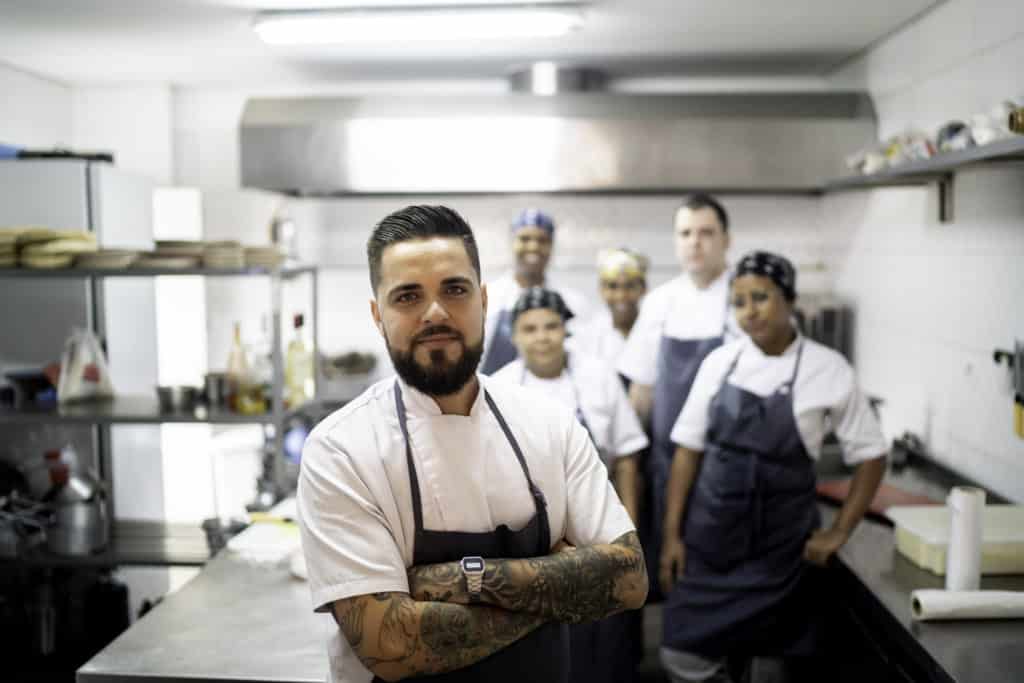This podcast and article originally appeared on Running Restaurants.com.
It was great having Tony Smith, CEO of Restaurant 365 back on the show. Tony shares a solid and refreshing take on building a company culture that any restaurant business can use to better attract and retain staff — everyone’s biggest challenge these days. We hit on a lot including…
- Tony’s back story & how tech has changed over time
- How operators can build a strong team and workplace culture that prioritizes retention
- The importance of Mission and Vision
- Showing growth path & career development to staff
- Data Driven Accountability
- Key aspects of having Mentors in the business
- AI & Robotics
- Ghost Kitchens
- Building powerful habits
- and more…
Lots of good stuff in this one…Check out the episode…and article version below…
Or read the condensed article version available below
Jaime: Tony, I realized in the three or four times we’ve spoken that we’ve never done a backstory on how you got to where you are. Run me through some of your past jobs, how did you get to where you are now at Restaurant 365?
Tony: I worked lots of jobs. I worked in Little Caesars in high school and plenty of other places. By the time I graduated college I had had 12 jobs. I went to school at BYU where I studied information systems. I became a software guy and was doing software for lots of different industries. We were mostly selling Microsoft business solutions. Two of the guys I was working with, Morgan Harris and John Moody (the other two founders of Restaurant 365), and I had wanted to build a tool for a specific industry instead of reselling Microsoft’s all the time. At that point we started looking for the right industry to dive into, one that really needed a robust web-based solution. We liked accounting and operational software and we found that the restaurant industry had that need. It was a large industry, so we thought there’d be plenty of room for us to play. Even though there were some other systems in the market doing some of those things, we didn’t see anyone doing everything we wanted to. So that’s really where the idea came from. We ended up starting Restaurant 365 in 2011. One other developer and I wrote the first lines of code and took off from there.
Jaime: Let’s pivot to what you guys do with Restaurant 365, what is the quick overview on Restaurant 365?
Tony: Restaurant 365 provides restaurant management and enterprise management software. We cover many aspects of the restaurant business including accounting, scheduling, inventory and recipe management, payroll, HR, and helping get and retain employees. Those are the primary features of our robust and all-in-one system.
Restaurant Labor Challenge
Jaime: What I want to talk about next, because it’s on everybody’s mind, is the labor shortage. It’s seemingly the number one concern across the country for restaurants right now. What are you seeing with the labor market side of the business?
Tony: Not a surprise to anyone, employers have had a tough time staffing their restaurants over the past year. During COVID a lot of them cut down on headcount and then they needed some mass hiring to fill back up. A number of them had a hard time doing that, and those that did had a really hard time keeping those people. Pre-pandemic, restaurant turnover was usually in the 70 to 75% range. Currently, there are some areas of the country where it’s been as high as 140% annual turnover. You can just imagine the headache that restaurants are going through trying to keep jobs staffed.
Building Culture
Jaime: On the hiring and retention side I want to talk about culture. How do you think about culture for your business? How do you see restaurants dealing with culture as a good retention tool?
Tony: In our business, culture is huge. That’s priority number one for me. Culture is not something that’s just going to happen; you have to build one that’s exciting and energizing to your employees. I think that everything else can fall in line when you’ve got that.
You have the things that you set, the high levels, such as your company purpose. For us, that’s helping restaurants thrive and grow. You also have your core values. For us, number one is “love good food”. We like that one because it’s not just the food, but we love our customers, right? Some of the other values share positive vibes: “relentlessly seek greatness” and “solve problems together.” Those are our core values. It’s important to have things like that that aren’t just for show, but that are things you actually use in the hiring process to find those people who are going to fit in well with your organization.
Another part of a culture that every business should have is a data element. You want to have a data-driven culture where people know that they have targets to shoot for and that they’ll be held accountable. It’s essential to choose how you’re going to create and communicate your vision or your goals. There are plenty of different mechanisms to use, but pick one and be consistent so that everyone is aware of what your goals are and what role they play in achieving them.
Finally, it’s to have an element of growth in your culture. No one wants to be stagnant. So having this element of growth, personal or organizational, can help people see how they can improve and how your business will become more.
JAIME Have you seen any of your restaurant clients use data well to assess, manage, and promote employees? What are some of the measurements they’re using that have been helpful?
Tony: One of the most important is prime profit — sales minus food cost minus labor cost. That’s the most controllable element for a lot of restaurant managers. I’ve seen several restaurants do that well. In out system restaurant can run a report, for example, that compares locations side by side. It anonymizes the names of the other locations, but you can sort and see who’s doing the best on food cost, who’s doing the best on labor, and you can go down to little details within those elements too. They can use this tool to see where they rank and it gets to be a little bit of a competition. Many restaurants also give a bonus based on the performance of those numbers.
Career Growth & Development
Jaime: Let’s go back into the growth aspect you talked about earlier. There are certainly great career development opportunities in hospitality. You talked about being challenged, getting rewarded, seeing a path forward – how have you seen folks be successful with showing a path towards growth?
Tony: We have a few different customers who have created “hire to promote” plans. They’re based on helping people who come in at the initial level move up to manager. I read that 8 or 9 out of 10 restaurant managers began as frontline employees, so that is a solid path to be able to show people.
There are a few key things you can do to help employees right from the beginning. During the interview process talk about the path and not just about the specific job they’re going to be doing day one. Another one is to help them get to know mentors who exemplify your culture and have been there a long time and have progressed. Being purposeful in showing them a good culture is crucial.
You also need to have a vision in your restaurant and make sure that they know their part in it. That part is really important because then they can see that they’re adding value. All employees like autonomy, mastery, and purpose in their job. With autonomy, it’s about how much they are getting to dictate about when they work or what they do. Can they gravitate towards things they like? That autonomy adds so much value outside of just the dollars that they get paid. Mastery is being confident in what we do. Purpose, of course, has to do with whether they feel like they’re really adding value and doing something helpful. They shouldn’t just be thinking: “I’m making a burrito.”
Those are three valuable things to focus on in your restaurant and we have seen a few customers that have been pretty successful at that.
Jaime: I want to call out your mention of mentorship. It’s great career advice to find a mentor, somebody who has been around and that you can learn from. General PSA: Folks, if you are already successful, please be a mentor to the folks that are coming up in the business.
Tony: I agree, it’s really valuable to gather info everywhere you can. I don’t see things as a hierarchy — oh, you wouldn’t waste time with someone who’s early in their career because they don’t know XYZ. Throughout my career, I have strived to talk to and learn from everyone.
Customer Loyalty
Jaime: I’m going to throw a couple of buzzwords at you. First is customer loyalty. How do you guys think about getting folks back into the restaurant?
Tony: These days, the restaurants we see doing a good job on that front are doing it through digital means. We see most of them capitalizing on it through their online ordering platform. Restaurants that have grabbed on to that customer data & identity have multiple ways to reach out to them. It’s tough if they’re doing it all through third parties because then the third party owns that customer information and the restaurant becomes just another food supplier. No one is going to love a food supplier. The real thing that keeps them coming back is their experience. As we’ve seen, it’s great to reach out through text or other avenues to remind them of the experience that is your restaurant versus just giving 15% off of the sandwich next time.
AI in Restaurants
Jaime: Yes, 100%, I always encourage restaurants to capture and use the data they get. This is a big miss for a lot of restaurants. If you have that data, please use it! Next buzzword I have for you is AI. What do you think about AI in the restaurant business?
Tony: AI is pretty exciting. You have the data analytic side to help you with sales forecasting, ordering recommendations, and scheduling recommendations. Our system works in those areas. That can be very helpful to run a streamlined restaurant.
It’s also fascinating to see the robotic side. At the National Restaurant Show in Chicago, I saw a giant robot that was mixing drinks. Granted, it was mixing them very slowly, but it was pretty neat. Then they would put them down onto a tray of another robot that would roll around and deliver the drinks. Now, I don’t think that that’s the world we’re going to live in next year, but it is interesting to see the different machine learning that has come into play — both with actual robotic devices as well as behind-the-scenes computing.
Ghost Kitchens
Jaime: Last buzzword for you — ghost kitchens. What are you seeing there?
Tony: There is plenty of success in that industry. There are lots of different ways to do it. There are kitchens cooking six brands and only doing delivery. There are restaurants using it to maximize profits. There’s definitely staying power there, though I don’t think that the whole industry is going to turn into it. I do think there’s a use for ghost kitchens because they do make delivery processes so much more efficient.
Book Recommendation
Jaime: One last thing, any new book recommendations to share?
Tony: The book I’m right in the middle of right now is Atomic Habits. I’m sure many people have read that one. That is a solid book if you read it with the idea of actually implementing some of those things, you really can change some aspects of your life. I’ve actually already made one change in my life because of it.
Jaime: Terrific book to share Tony! A recent read for me as well and I highly recommend it! Thanks again for joining me Tony.



